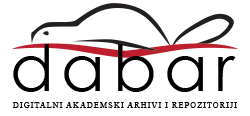| Abstract | Djeca počinju stvarati svoje prve umjetničke radove i likovno se izražavati već od prve godine života. Vesele se crtama koje sami stvaraju koriste i razne predmete, istražujući mogućnosti, razvijaju i percepciju i motoriku te, najvažnije, zadovoljavaju i svoju unutarnju potrebu za izražavanjem. Kroz crteže, djeca izražavaju svoje misli i doživljaje iz okoline te tumače svijet koji ih okružuje. Njihovi crteži pružaju uvid u njihov razvoj i emocije. S rastom djeteta, crteži postaju složeniji i detaljniji. Likovne aktivnosti ključni su dio svih aktivnosti u dječjem vrtiću. One potiču cjelokupni razvoj djeteta, posebno kreativnost, inovativnost i maštu. Važno je da odgajatelji poznaju materijale i znaju kako ih koristiti. Također, prilikom odabira likovnih tehnika, važno je da alati i materijali budu sigurni za djecu. Likovne tehnike uključuju crtanje, slikanje, grafiku i trodimenzionalne tehnike, a svaka se može podijeliti prema korištenim materijalima ili metodama. Da bi odgajatelj uspješno provodio likovne aktivnosti, treba dobro poznavati ponuđene tehnike, prilagoditi ih mogućnostima djece i stvoriti poticajno okruženje. Potrebno je osigurati pažljivo osmišljene poticaje i razne materijale, uvažavati individualnost i interese djece, te im omogućiti slobodu i izbor.
Ovaj završni rad obuhvaća sedam poglavlja. Uvodno poglavlje upoznaje čitatelje s temom rada. U drugom poglavlju kratko je prikazano dječje likovno stvaralaštvo. Treće poglavlje donosi pregled i opis likovnih tehnika te njihove razlike. Četvrto poglavlje se posvećuje grafičkim likovnim tehnikama. Peto poglavlje razmatra grafičke tehnike prikladne za rad s djecom rane i predškolske dobi, detaljno ih opisuje i uključuje primjere praktičnih radova. Na kraju rada nalaze se zaključak, popis literature i prilozi. |
| Abstract (english) | Children begin creating their first artworks and expressing themselves visually as early as their first year of life. They delight in the lines they create using various objects, exploring possibilities, developing perception and motor skills, and, most importantly, fulfilling their internal need for expression. Through drawings, children convey their thoughts and experiences from their surroundings and interpret the world around them. Their drawings provide insight into their development and emotions. As the child grows, their drawings become more complex and detailed. Artistic activities are a crucial part of all activities in a preschool. They promote the overall development of the child, especially creativity, innovation, and imagination. It is important for educators to be familiar with materials and know how to use them. Additionally, when selecting artistic techniques, it is crucial that the tools and materials are safe for children. Artistic techniques include drawing, painting, graphics, and three-dimensional techniques, each of which can be categorized according to the materials or methods used. For an educator to effectively conduct artistic activities, they need to have a good understanding of the available techniques, adapt them to the children's capabilities, and create a stimulating environment. It is necessary to provide carefully designed stimuli and various materials, respect the individuality and interests of the children, and allow them freedom and choice.
This thesis encompasses seven chapters. The introductory chapter familiarizes readers with the topic of the paper. The second chapter briefly presents children's artistic creation. The third chapter provides an overview and description of artistic techniques and their differences. The fourth chapter is dedicated to graphic artistic techniques. The fifth chapter examines graphic techniques suitable for working with young children and preschoolers, describes them in detail, and includes examples of practical works. The conclusion, bibliography, and appendices are found at the end of the paper. |

